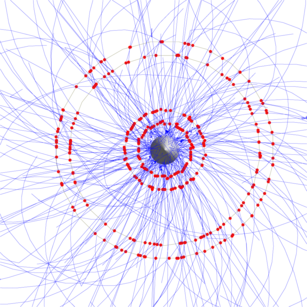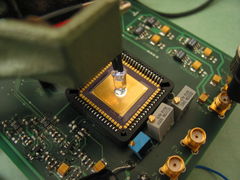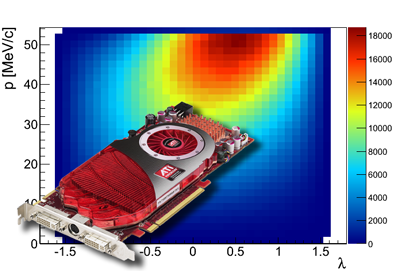The Berger research group has moved to the Johannes-Gutenberg University Mainz -
visit our new site in Mainz.
Research Group Niklaus Berger
Research: The Mu3e Experiment
The Mu3e Experiment searches for the lepton-flavour violating decay of the muon to three electrons. A detailled description of the experiment can be found on the homepage at the Paul Scherrer Institute (PSI).In order to reconstruct the decay electrons as precisely as possible, we are building a silicon detector with 300 million pixels. To reduce multiple scattering in the detector material, the sensors will be thinned to 50 microns.
The experiment is designed to reach a sensitivity of one in 1016 muon decays, which requires observing two billion decays every second. This in turn leads to a data rate of about 1 Tbit/s. The task of my group is to read out these data and to reconstruct the electron tracks with the best possible precision. In order to achieve this with the necessary speed and withhin a limited space and power budget, we use programmable logic (FPGAs), optical links and computers with powerful graphics processing units. Currently we are active in the following areas:
Simulation
 Using a detailled simulation, we optimize the detector design. This requires detailled modelling
of muon decays as well as the geometry and material properties of the detector. In close collaboration
with the workshops at the physics institute, we work to find solutions that are both performant in
terms of the physics reach and technically feasible.
Using a detailled simulation, we optimize the detector design. This requires detailled modelling
of muon decays as well as the geometry and material properties of the detector. In close collaboration
with the workshops at the physics institute, we work to find solutions that are both performant in
terms of the physics reach and technically feasible.
In order to verify the simulation, we regularly perform test beam measurements at e.g. CERN or PSI.
The simulation also allows us to predict data rates, which in turn shapes the design of the read-out electronics. The electronics design is then fed back into the simulation in order to estimate the effects of dead time, buffer overflows etc.
Track reconstruction
 One of the main challenges for the Mu3e experiment is the reconstruction of up to two billion
particle tracks every second. This with limited computing power, but still aiming for ultimate
precision.
One of the main challenges for the Mu3e experiment is the reconstruction of up to two billion
particle tracks every second. This with limited computing power, but still aiming for ultimate
precision.
One read-out frame will contain up to one hundred electron tracks. Reconstructing these tracks from hundreds of hits in the pixel detector without assigning hits to the wrong track is a challenging problem of pattern recognition. We attempt to tackle this challenge using fast and efficient algorithms tailored for FPGAs and graphics processing units.
The next step is then determining the electron momenta through a track fit. As the tracks are strongly distorted by multiple scattering in the detector material, also this step poses a challenge. We are evaluating various techniques, such as broken line fits and Kalman filters to obtain the best possible resolution with short computing times.
Data Aquisistion
 The final Mu3e detector will produce about a Tbit of data per second. Reading out these data
is one of the tasks of my group. We use FPGAs directly on the detector to synchronize the
data and perform zero-suppression. Optical links then forward the data to read-out boards,
where another set of FPGAs serves as switches, assuring that every reconstruction PC sees
data from the complete detector.
The final Mu3e detector will produce about a Tbit of data per second. Reading out these data
is one of the tasks of my group. We use FPGAs directly on the detector to synchronize the
data and perform zero-suppression. Optical links then forward the data to read-out boards,
where another set of FPGAs serves as switches, assuring that every reconstruction PC sees
data from the complete detector.
Data Analysis

Between the raw data of the experiment and the final measurement lies a careful data analysis. My group is preparing for this by analyzing simulated data and test-beam measurements. Thus we can hone our skills and optimize our algorithms in order to obtain the most sensitive measurement of the branching fraction mu -> eee.



